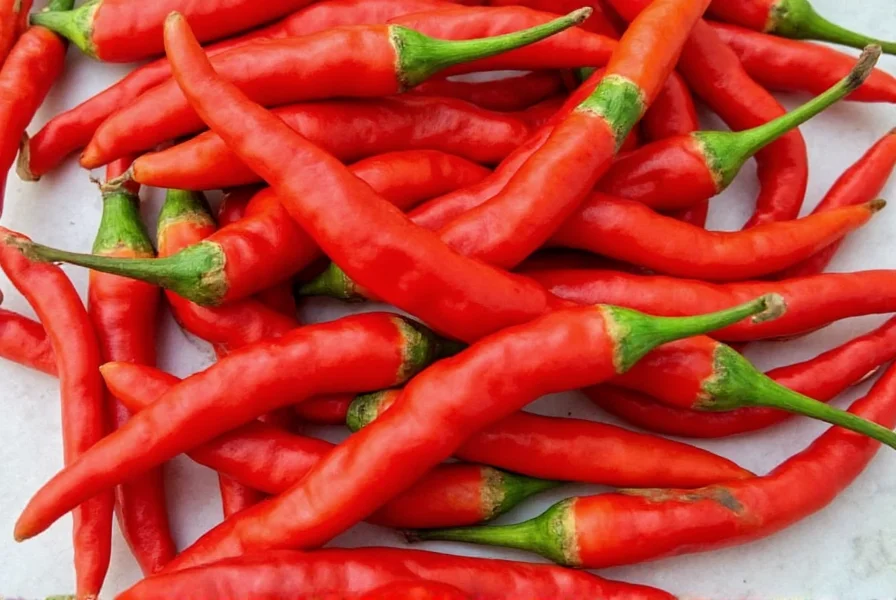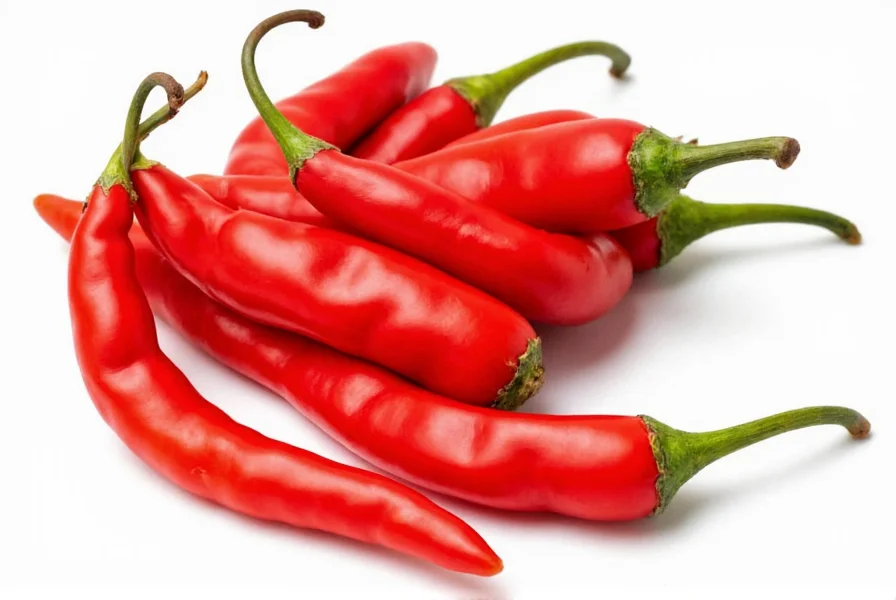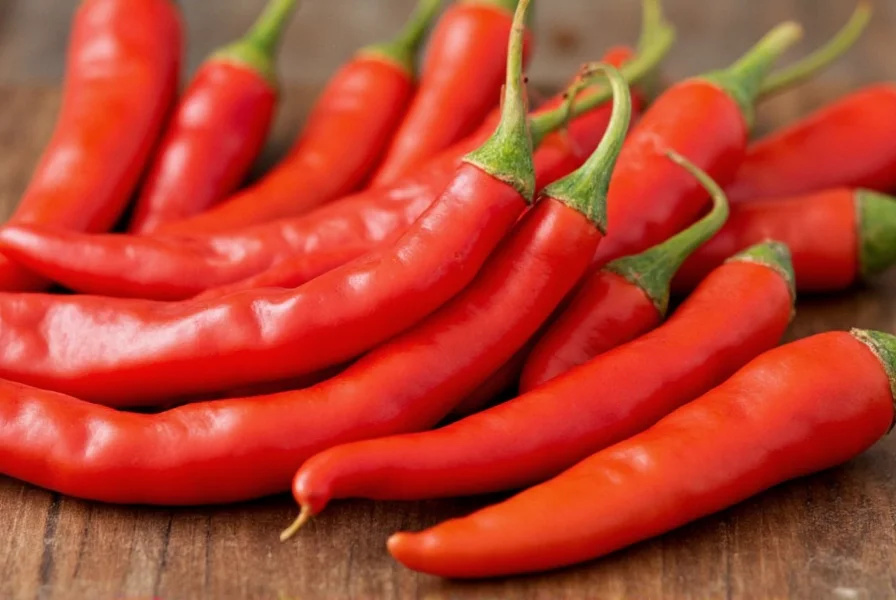Fresh cayenne peppers transform ordinary dishes with their bright, fruity heat and complex flavor profile. These slender, tapered chilies start green and mature to brilliant red, reaching 2-5 inches in length with thin walls perfect for slicing or mincing. Understanding how to properly select, handle, and incorporate fresh cayenne into your cooking unlocks culinary possibilities beyond what dried alternatives offer.
Physical Characteristics and Heat Profile
Fresh cayenne peppers display distinctive physical traits that differentiate them from other chili varieties. Their smooth, glossy skin transitions from dark green to vibrant red as they ripen. The peppers typically measure 1/2 inch in diameter with a tapered shape ending in a pointed tip. Internally, they contain white pith and numerous flat, pale yellow seeds that house significant capsaicin concentration.
The heat level of fresh cayenne ranges from 30,000 to 50,000 Scoville Heat Units, placing them firmly in the medium-hot category. This heat manifests differently than dried cayenne powder due to the fresh pepper's moisture content and volatile compounds. Fresh cayenne delivers an immediate, sharp heat that peaks quickly but doesn't linger as long as dried versions. The flavor profile includes citrusy notes and subtle fruitiness absent in processed forms.
| Characteristic | Fresh Cayenne Pepper | Dried Cayenne Powder |
|---|---|---|
| Heat Level (SHU) | 30,000-50,000 | 30,000-50,000 |
| Flavor Profile | Fruity, citrusy, bright | Earthy, smoky, concentrated |
| Moisture Content | 80-90% | 5-10% |
| Heat Development | Immediate, shorter duration | Slower build, longer duration |
| Storage Life | 2-3 weeks refrigerated | 6-12 months |
Practical Handling and Safety Considerations
Working with fresh cayenne requires proper handling techniques to prevent skin and eye irritation. Always wear disposable gloves when cutting or processing these peppers. The capsaicin oils easily transfer to skin and can cause significant burning sensations, especially when touching your face or eyes.
When preparing fresh cayenne pepper, follow these safety guidelines:
- Work in a well-ventilated area to avoid inhaling capsaicin particles
- Use a dedicated cutting board that won't transfer oils to other foods
- Remove seeds and white pith carefully using a small spoon
- Wash hands thoroughly with soap and water after handling, even when wearing gloves
- Never rub your eyes during or immediately after handling
If you experience skin irritation, apply milk or yogurt to the affected area rather than water, as capsaicin is oil-soluble. For severe reactions, consult a healthcare professional.

Culinary Applications and Substitution Guide
Fresh cayenne pepper shines in applications where its bright flavor and immediate heat can enhance dishes. Unlike dried cayenne, which works best in long-cooked sauces and rubs, fresh peppers excel in quick-cooking applications. Add minced fresh cayenne during the last 5-10 minutes of cooking to preserve its vibrant flavor notes.
When substituting fresh cayenne for dried cayenne powder, use this conversion guide:
- 1 fresh cayenne pepper (minced) ≈ 1/8 teaspoon cayenne powder
- 1 tablespoon fresh cayenne (minced) ≈ 1/2 teaspoon cayenne powder
Remember that fresh cayenne delivers heat more immediately but with less longevity than dried powder. Adjust quantities based on your heat tolerance and the dish's cooking time. For raw applications like salsas or fresh sauces, fresh cayenne provides superior flavor complexity compared to dried alternatives.
Optimal Storage Methods
Proper storage extends the shelf life of fresh cayenne peppers while maintaining their quality. Store unwashed peppers in the crisper drawer of your refrigerator inside a perforated plastic bag. This method preserves moisture while allowing airflow, typically keeping peppers fresh for 2-3 weeks.
For longer storage, consider these preservation methods:
- Freezing: Wash, dry, and freeze whole peppers in airtight containers for up to 6 months. Frozen peppers work well for cooking but lose crispness.
- Vinegar preservation: Create quick-pickled cayenne peppers by submerging in equal parts vinegar and water with 1 tablespoon salt per cup.
- Drying: String peppers on twine and hang in a warm, dry location, or use a food dehydrator to create your own cayenne powder.

Nutritional Profile and Research-Backed Benefits
Fresh cayenne peppers offer notable nutritional benefits beyond their heat. A single 14-gram pepper provides approximately:
- 9 calories
- 20% of daily vitamin C needs
- 5% of daily vitamin A needs
- Trace amounts of vitamin B6, potassium, and manganese
The active compound capsaicin has been studied for potential health benefits. Research indicates capsaicin may support metabolic health by temporarily increasing thermogenesis. Studies published in the Journal of Nutritional Science and Vitaminology suggest regular consumption of chili peppers correlates with certain cardiovascular benefits. However, these findings represent general trends and shouldn't be interpreted as medical advice.
Growing Your Own Fresh Cayenne
Growing fresh cayenne peppers at home provides access to the freshest possible product. These plants thrive in warm climates with full sun exposure and well-draining soil. Start seeds indoors 8-10 weeks before your last frost date, then transplant outdoors when soil temperatures exceed 70°F (21°C).
For optimal growth:
- Provide 6-8 hours of direct sunlight daily
- Maintain consistent soil moisture without waterlogging
- Fertilize monthly with balanced vegetable fertilizer
- Harvest peppers when fully colored but still firm
Container gardening works well for cayenne peppers, making them suitable for patios or balconies. Most varieties mature in 70-80 days from transplanting, yielding abundant harvests throughout the growing season.
Conclusion
Fresh cayenne pepper offers culinary advantages that dried alternatives cannot replicate. Its vibrant flavor, immediate heat profile, and versatility make it valuable for home cooks seeking to elevate their dishes. By understanding proper handling techniques, storage methods, and substitution ratios, you can confidently incorporate fresh cayenne into your cooking repertoire while enjoying its distinctive characteristics.
Frequently Asked Questions
Can I substitute fresh cayenne pepper for dried cayenne powder in recipes?
Yes, but with important adjustments. Use 1 minced fresh cayenne pepper to replace 1/8 teaspoon of cayenne powder. Remember that fresh cayenne delivers heat more immediately but with less longevity than dried powder. For best results, add fresh cayenne during the last 5-10 minutes of cooking to preserve its vibrant flavor.
How can I reduce the heat of fresh cayenne pepper while keeping flavor?
Remove the white pith and seeds, which contain the highest concentration of capsaicin. Soaking sliced peppers in milk or salted water for 10-15 minutes can also reduce heat intensity while preserving flavor. For milder applications, use just the outer flesh of the pepper, discarding the interior membranes.
Why does fresh cayenne pepper feel different than dried cayenne?
Fresh cayenne contains volatile compounds that create an immediate, sharp heat sensation, while dried cayenne delivers a slower-building, longer-lasting heat. The moisture content in fresh peppers affects how capsaicin interacts with your taste receptors, creating a different sensory experience despite similar Scoville ratings.
How do I safely handle fresh cayenne peppers without getting burned?
Always wear disposable gloves when handling fresh cayenne peppers. Work in a well-ventilated area and avoid touching your face. Use a dedicated cutting board and wash all surfaces thoroughly with soapy water afterward. If you experience skin irritation, apply milk or yogurt to the affected area rather than water, as capsaicin is oil-soluble.
What's the best way to store fresh cayenne peppers for maximum shelf life?
Store unwashed fresh cayenne peppers in the crisper drawer of your refrigerator inside a perforated plastic bag. This preserves moisture while allowing airflow, typically keeping peppers fresh for 2-3 weeks. For longer storage, freeze whole peppers in airtight containers for up to 6 months or preserve in vinegar for quick-pickled peppers.











 浙公网安备
33010002000092号
浙公网安备
33010002000092号 浙B2-20120091-4
浙B2-20120091-4